2018 | Buch
Mathematical Software – ICMS 2018
6th International Conference, South Bend, IN, USA, July 24-27, 2018, Proceedings
herausgegeben von: James H. Davenport, Manuel Kauers, George Labahn, Josef Urban
Verlag: Springer International Publishing
Buchreihe : Lecture Notes in Computer Science
